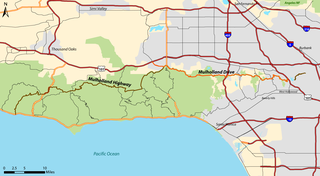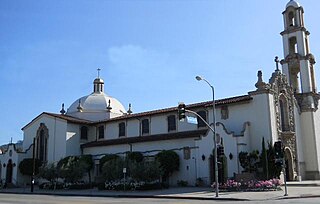
Hollywood is a neighborhood in the central region of Los Angeles, California. Its name has come to be a shorthand reference for the U.S. film industry and the people associated with it. Many notable film studios, such as Columbia Pictures, Walt Disney Studios, Paramount Pictures, Warner Bros., and Universal Pictures, are located near or in Hollywood.

Sunset Boulevard is a boulevard in the central and western part of Los Angeles, California, that stretches from the Pacific Coast Highway in Pacific Palisades east to Figueroa Street in Downtown Los Angeles. It is a major thoroughfare in the cities of Beverly Hills and West Hollywood, as well as several districts in Los Angeles.

The Pacific Electric Railway Company, nicknamed the Red Cars, was a privately owned mass transit system in Southern California consisting of electrically powered streetcars, interurban cars, and buses and was the largest electric railway system in the world in the 1920s. Organized around the city centers of Los Angeles and San Bernardino, it connected cities in Los Angeles County, Orange County, San Bernardino County and Riverside County.

Mulholland Drive is a street and road in the eastern Santa Monica Mountains of Southern California. It is named after pioneering Los Angeles civil engineer William Mulholland. The western rural portion in Los Angeles and Ventura Counties is named Mulholland Highway. The road is featured in a significant number of films, songs, and novels. David Lynch, who wrote and directed a film named after Mulholland Drive, has said that one can feel "the history of Hollywood" on it. Academy Award–winning actor Jack Nicholson has resided at Mulholland Drive for many years and still lives there today.

North Hollywood is a neighborhood of Los Angeles, California, located in the San Fernando Valley. The neighborhood contains the NoHo Arts District, the El Portal Theatre, several art galleries, and the Academy of TV Arts and Sciences. The North Hollywood Metro Rail station is one of the few subway-accessible Metro Rail stations in Los Angeles.

The Arroyo Seco Parkway, also known as the Pasadena Freeway, is one of the oldest freeways built in the United States. It connects Los Angeles with Pasadena alongside the Arroyo Seco seasonal river. It is notable not only for being an early freeway, mostly opened in 1940, but for representing the transitional phase between early parkways and modern freeways. It conformed to modern standards when it was built, but is now regarded as a narrow, outdated roadway. A 1953 extension brought the south end to the Four Level Interchange in downtown Los Angeles and a connection with the rest of the freeway system.

Old Pasadena, often referred to as Old Town Pasadena or just Old Town, is the original commercial center of Pasadena, a city in California, United States, and had a latter-day revitalization after a period of decay.

Hollywood Boulevard is a major east–west street in Los Angeles, California. It begins in the east at Sunset Boulevard in the Los Feliz district and proceeds to the west as a major thoroughfare through Little Armenia and Thai Town, Hollywood. After crossing Fairfax Avenue, Hollywood Boulevard ends at a stop sign, at Laurel Canyon Drive, and continues northbound, as a winding residential street, going up in the hills and canyons in the Hollywood Hills West district. Parts of the boulevard are popular tourist destinations, primarily the fifteen blocks between Gower Street west to La Brea Avenue where the Hollywood Walk of Fame is located. The heart of Hollywood Boulevard is the crossing of Hollywood Boulevard and Highland avenue. "Hollywood and Highland" is the exit to Hollywood via the 101 freeway, and the station when exiting the bus or metro red lines.

Moses Hazeltine Sherman was an American land developer who built the Phoenix Street Railway in Phoenix, Arizona and streetcar systems that would become the core of the Los Angeles Railway and part of the Pacific Electric Railway in Los Angeles, California, and owned and developed property in areas such as the westside of Los Angeles, the San Fernando Valley and Hollywood, California. He also served on the Los Angeles Water Board. He was also known as M. H. Sherman and General M. H. Sherman.

The Hollywood Hotel was a famous hotel, society venue of early Hollywood, and landmark, formerly located at 6811 Hollywood Boulevard, on the north side, extending from Highland Avenue to Orchid Avenue, in central Hollywood, Los Angeles, California.

Los Angeles has a complex multimodal transportation infrastructure, which serves as a regional, national and international hub for passenger and freight traffic. The system includes the United States' largest port complex; an extensive freight and passenger rail infrastructure, including light rail lines and rapid transit lines; numerous airports and bus lines; vehicle for hire companies; and an extensive freeway and road system. People in Los Angeles rely on cars as the dominant mode of transportation, but since 1990 Los Angeles Metro Rail has built over one hundred miles (160 km) of light and heavy rail serving more and more parts of Los Angeles. As a result, Los Angeles was the last major city in the United States to get a permanent rail system installed.
Laurel Canyon is a mountainous neighborhood in the Hollywood Hills region of the Santa Monica Mountains, within the Hollywood Hills West district of Los Angeles, California. The main thoroughfare of Laurel Canyon Boulevard connects the neighborhood with the more urbanized parts of Los Angeles to the north and south, between Ventura Boulevard and Hollywood Boulevard.

Wilshire Boulevard is a prominent 15.83 mi (25.48 km) boulevard in the Los Angeles area of Southern California, extending from Ocean Avenue in the city of Santa Monica east to Grand Avenue in the Financial District of downtown Los Angeles. One of the principal east-west arterial roads of Los Angeles, it is also one of the major city streets through the city of Beverly Hills. Wilshire Boulevard runs roughly parallel with Santa Monica Boulevard from Santa Monica to the west boundary of Beverly Hills. From the east boundary it runs a block south of Sixth Street to its terminus.

Cahuenga Boulevard is a major boulevard of northern Los Angeles, California, US. The “Cahuenga” name is a Spanish, phonetic derivative with no actual Spanish language meaning that is attributed to the Tongva village of Kawengna, meaning "place of the mountain". It connects Sunset Boulevard in the heart of old Hollywood to the Hollywood Hills and North Hollywood in the San Fernando Valley.

The Pasadena via Oak Knoll Line was an interurban route of the Pacific Electric Railway. It operated from 1906 until 1950, between Downtown Los Angeles and Downtown Pasadena, California. Cars ran as far as Altadena during rush hours.

The South Hollywood–Sherman Line was a suburban route of the Pacific Electric Railway. The line ran between Downtown Los Angeles and the suburb of Sherman. The line was named after Moses Sherman, who built the line and the Sherman street car yard on the line in West LA. The large 5.56-acre (2.25 ha) rail facility was on Santa Monica Boulevard just west of La Cienega Boulevard. The yard had a steam power house, a car barn and a shop building.

The Owensmouth Line was a Pacific Electric interurban service that connected the San Fernando Valley to Downtown Los Angeles. The route was largely developed as the result of real estate speculation.

The Hollywood Line was a local streetcar line of the Pacific Electric Railway. It primarily operated between Downtown Los Angeles and Hollywood, with some trips as far away as Beverly Hills and West Los Angeles. It was the company's busiest route prior to the opening of the Hollywood Subway. Designated as route 32, the line operated from 1909 until 1953.
J was a streetcar line in Los Angeles, California. It was operated by the Los Angeles Railway from 1911 to 1945, by Los Angeles Transit Lines from 1945 to 1958, and by the Los Angeles Metropolitan Transit Authority from 1958 to 1963.

The Los Angeles Pacific Railroad (1896−1911) (LAP) was an electric public transit and freight railway system in Los Angeles County, California. At its peak it had 230 miles (370 km) of track extending from Downtown Los Angeles to the Westside, Santa Monica, and the South Bay towns along Santa Monica Bay.

















